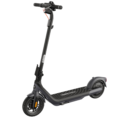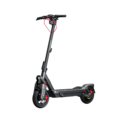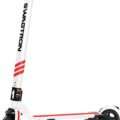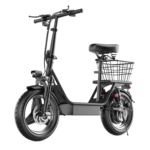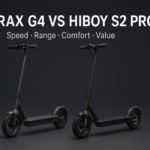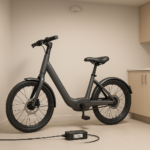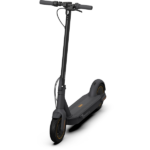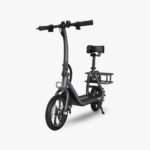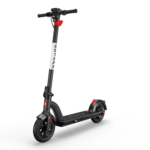- Home
- Scooters
- Electric Scooters
- Segway Ninebot ZING C9
Segway Ninebot ZING C9


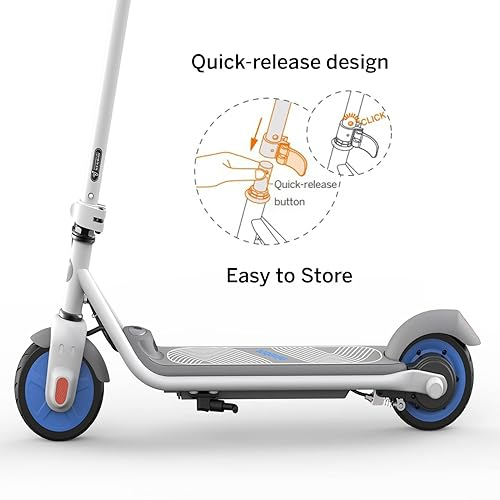
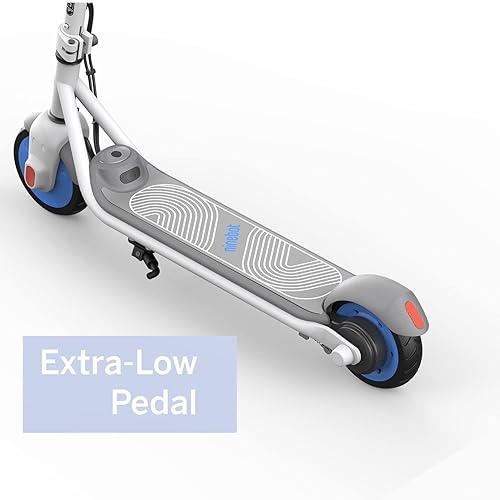
- Battery Range: 10 km (6.2 mi)
- Top Speed: 18 km/h (11.2 mph)
- Motor Power: 150 W nominal
- Weight Capacity: 60 kg (132 lb)
- Charging Time: 3 h
- Scooter Weight: 8.1 kg (17.9 lb)
PROS
- Faster 18 km/h top speed
- Larger cockpit for 130–160 cm riders
- Lightweight and easy to carry
- Predictable hand brake feel
- Simple charging (~3 h)
CONS
- Short typical range
- No full suspension
- No app connectivity
- Rear light not included
- Solid tyres feel firm on rough brick
Overview: A Step Up for Older Kids
The Segway Ninebot C9 moves older kids into a faster, taller, and more confident platform—while staying refreshingly simple to operate. It lifts top speed to about 18 km/h (11.2 mph), preserves a practical ~10 km range, and adds a larger cockpit sized for riders roughly 130–160 cm tall. Because it blends a responsive hand brake with stable geometry, control stays predictable on neighborhood routes, school-yard loops, and park paths. Moreover, with a nominal 150 W motor (180 W max) and a rated payload up to 60 kg, the C9 carries growing riders without drama. Charging takes about 3 hours, and the scooter remains easy to handle at ~8.1 kg. Consequently, the C9 becomes a smart bridge between smaller beginner models and teen-focused scooters—exactly the “step up” many families want.
Who the Segway Ninebot C9 Is For (and Why It Fits)
The C9 suits families whose riders have outgrown entry-level kids’ scooters but aren’t ready for teen performance models. Specifically, it’s ideal for:
- Older kids who need more room, a bit more speed, and steadier handling.
- Parents who value predictable braking, simple upkeep, and clear, confidence-building controls.
- Neighborhood and park routes where measured speed and stable steering matter more than flash.
- Households that appreciate a scooter light enough to carry but sturdy enough for growth.
Because the C9 focuses on control before complexity, riders progress quickly yet safely. As a result, daily rides feel fun, calm, and repeatable.
Design Philosophy: Taller Cockpit, Stable Geometry
At first glance, the C9 looks clean and purposeful. However, the details reveal why it works so well for bigger kids:
- Roomier cockpit: Bars sit at a comfortable reach for 130–160 cm riders, which reduces over-correction and smooths steering.
- Low, grippy deck: A sensible deck height lowers the center of gravity, so line changes feel composed—even at higher kid speeds.
- Balanced stance: The chassis encourages a staggered foot position (front foot angled, rear foot slightly offset), which squares the hips and stabilizes the torso.
Consequently, kids step on, feel instantly “at home,” and start focusing on the path—not on the scooter.
Motor & Speed: Smooth Power at ~18 km/h
On youth scooters, how power arrives matters more than the number on the box. Accordingly, the C9’s 150 W nominal drive (up to 180 W max) is tuned for smooth launches and steady cruising rather than jumpy surges. Therefore, first accelerations feel controlled, elbows stay soft, and riders keep eyes up. At about 18 km/h, the top speed lands in a sweet spot: lively enough to feel “grown-up,” yet measured enough to keep stopping distances sensible.
Good habits to coach:
- Roll on the throttle gradually to keep the chassis centered.
- Look through turns and plan lines early.
- Leave space for gentle deceleration before intersections.
Because these cues are simple, confidence grows ride by ride.
Braking & Control: Responsive Lever, Predictable Stops
The C9’s hand-operated brake delivers progressive lever feel, so kids learn modulation—not panic grabs. Additionally, the stable geometry keeps weight transfer manageable during harder stops. To turn technique into muscle memory, begin each session with a 20-second drill:
- Glide at walking pace,
- Squeeze smoothly until stopped,
- Hold the line upright—no skids, no wobbles.
As a result, riders master braking precision quickly and carry that skill into real-world routes.
Range & Charging: Simple Routines, Predictable Days
With roughly 10 km of range in favorable conditions, the C9 comfortably covers school-yard sessions, neighborhood errands, and weekend laps. Meanwhile, ~3-hour charging fits easily between homework and dinner or during a quiet evening.
Parent-friendly battery tips:
- Try to stay above ~20% for day-to-day use; avoid frequent deep discharges.
- If pausing riding for weeks, store around half charge.
- Charge and store indoors, away from temperature extremes.
- Power the scooter off after rides to minimize idle drain.
Consequently, the pack stays healthy and range remains consistent across seasons.
Handling & Stability: Composure That Scales With Speed
As kids grow taller and heavier, scooters must remain calm across bumps and direction changes. The C9’s stable geometry and low deck help it track straight over seams and bricks, while the longer cockpit gives riders leverage to steer decisively without twitch. Furthermore, the frame’s weight distribution feels even, so mid-corner corrections don’t unsettle the chassis. Therefore, riders experience a pleasant, “centered” feel that encourages better lines—and better choices.
Tyres & Ride Feel: Simple, Durable, Everyday-Ready
Maintenance should be the last thing on your mind. The C9’s tyres are designed for low fuss, high reliability, which keeps flats rare and checks quick. Admittedly, maintenance-friendly tyres can transmit a bit more surface texture than large pneumatic ones; however, the C9’s measured speed and stable stance keep comfort in a friendly zone for daily routes.
Comfort cues that help immediately:
- Keep a gentle knee bend to absorb vibration.
- Scan ahead and pick straighter lines through cracks.
- Roll over small seams rather than swerving late.
Because these micro-skills are easy to practice, rides feel smoother almost at once.
Fit & Ergonomics: Sized for 130–160 cm Riders
Proper fit multiplies control. When standing tall on the deck, the handlebars should land around mid-chest height with slight elbow bend. If elbows lock straight, steering gets harsh; if arms crowd the torso, leverage disappears. Additionally, check stance: front foot angled, rear foot slightly offset, shoulders relaxed. Consequently, turns smooth out, braking stays upright, and fatigue drops—especially on longer park loops.
Weight, Payload & Portability: Light to Lift, Built to Grow
Although the C9 is sturdier than smaller kids’ models, it still weighs about 8.1 kg, which keeps carries practical for adults and short repositioning easy for kids. Moreover, the rated payload up to 60 kg supports growth spurts without stressing the system. Because the chassis hits this balance, the scooter feels “big kid ready” without becoming cumbersome.
Weather Readiness: Sensible Limits Keep Rides Going
Life doesn’t stop for a sprinkle. While you should always avoid downpours and standing water, light splashes with sensible care are manageable on short routes. Therefore, teach riders to:
- Brake earlier when surfaces look shiny,
- Keep stops upright in the wet, and
- Wipe the scooter dry after damp sessions—especially the deck and controls.
As a result, the scooter stays reliable, and routine stays intact.
Four-Week Progression (That Feels Like a Game)
Week 1 — Starts & Stops:
Empty court, smooth surface. Practice gentle launches and “silent stops” (no squeaks, no skids). Celebrate three perfect attempts.
Week 2 — Smooth Steering:
Chalk wide S-turns, connect them at steady pace, and keep eyes up. Add speed only after lines look clean.
Week 3 — Real Routes & Etiquette:
Move to a quiet loop. Teach single-file riding, early speed control, and polite passing. Layer in short “best line” segments.
Week 4 — Planning & Responsibility:
Let riders announce the safety checklist. Set a landmark goal plus a battery buffer, then finish with a “Stop on the Dot” challenge for braking precision.
Consequently, skill and confidence rise together—without rushing.
Family Safety Checklist (Fast & Friendly)
- Helmet on, straps snug (two-finger rule under the chin).
- Closed-toe shoes—no sandals or dangling laces.
- Brake test at walking pace before the first long glide.
- Path scan for pets, prams, and potholes.
- Ride right, pass politely, and avoid weaving through crowds.
- No headphones; eyes and ears stay free.
Because this routine takes under a minute, kids soon lead it themselves.
Maintenance: Low Effort, High Confidence
The C9 is deliberately maintenance-light. Nevertheless, a tiny routine keeps performance crisp:
- Weekly: Wipe the deck and reflectors; quick bolt glance on stem and axle areas.
- Monthly: Check brake lever feel and cable condition; inspect tyres for cuts or embedded debris.
- Quarterly: Clean the charging port and cap; do a slow fastener check.
- Seasonally: Review overall condition; refresh any manufacturer-recommended consumables.
Therefore, more time goes to riding, not repairing.
Parent & Rider FAQs
Is ~18 km/h too fast for older kids?
With supervision, a helmet, and good braking habits, no. The speed feels lively yet stays manageable for short city paths.
How far will ~10 km really go?
On flat ground and steady pace, it covers typical neighborhood loops. Hills, cold temps, and frequent stops reduce range, so plan a buffer.
Can we ride after a light sprinkle?
Brief, light splashes are workable with caution. Avoid heavy rain and puddles, brake earlier, and wipe the scooter dry afterward.
Does the C9 climb hills?
The 150 W nominal (180 W max) drive handles gentle neighborhood inclines best. On steeper grades, speed will drop; use a push assist if necessary.
Is it easy to carry?
Yes. At roughly 8.1 kg, adults can lift it comfortably, and kids can help with doors or short moves.
What about rider size and weight?
The cockpit suits ~130–160 cm riders, and the scooter is rated for payloads up to 60 kg, which covers most older kids.
When the C9 Might Not Be Ideal
Clarity helps everyone. The C9 may not suit riders who need:
- Higher top speed for older teens,
- Long-distance range beyond neighborhood use, or
- Off-road capability with large pneumatic tyres and suspension.
If those needs sound familiar, consider stepping up to a teen-oriented model. Otherwise, the C9’s blend of speed, size, and simplicity is exactly the point.
Final Verdict: The Smart Bridge to Teen Scooters
The Segway Ninebot C9 is a thoughtful step up for older kids. It raises top speed to about 18 km/h, maintains a practical ~10 km range, and scales cockpit size for 130–160 cm riders. In addition, its 150 W nominal / 180 W max motor, responsive hand brake, and stable geometry keep control predictable as skills grow. Because it charges in ~3 hours, carries up to 60 kg, and weighs only ~8.1 kg, it slides naturally into family life. Consequently, the C9 bridges the gap between small beginner scooters and teen-focused models—delivering confidence, convenience, and daily fun.
Specifications
General
| Model The Model specifies the exact version or name of the scooter. It helps identify its unique design, features, and specifications within the manufacturer’s product line. Knowing the model makes it easier to compare options, find compatible accessories, or look up support information. | Ninebot ZING C9 |
| Brand The Brand identifies the manufacturer or company that designs and produces the scooter. A trusted brand is a sign of quality, reliability, and good customer support. Well-known brands often have higher standards for safety, performance, and after-sales service, giving you more confidence in your purchase. | Segway |
| Release Date The Release Date indicates when the scooter model was officially launched on the market. This helps you know how current the design, technology, and features are. A newer release date often means updated components, improved performance, and the latest safety or smart features. | 17 November 2025 |
| Recommended Age Recommended Age indicates the minimum age range that the scooter is designed for, based on safety, size, and ease of use. Following the recommended age helps ensure that riders can handle the scooter’s speed, weight, and controls comfortably and safely. Always check local laws and use protective gear, especially for younger riders. | Appropriate age 8–14 |
Performance & Power
| Motor Power (Wattage) What it means: The motor power, measured in watts (W), shows how strong the scooter’s electric motor is. Why it matters: Higher wattage usually means better acceleration, more torque, and improved performance on hills or rough terrain. For example, a 250W motor is good for flat city roads and light riders, while a 500W or 1000W motor provides more power for faster speeds or climbing steep inclines. | 150 W nominal (180 W max) |
| Top Speed The Top Speed indicates the maximum speed that the scooter can reach under optimal conditions. It’s usually measured on level ground with a fully charged battery and an average rider weight. A higher top speed allows you to travel longer distances faster, but always ensure you ride within legal speed limits and your personal comfort zone for safety. | 18 km/h (11.2 mph) |
| Battery Capacity Battery Capacity refers to the total amount of energy the scooter’s battery can store, usually measured in ampere-hours (Ah) or watt-hours (Wh). A higher battery capacity means you can ride longer distances on a single charge, reducing the need for frequent recharging. Keep in mind that actual range can vary depending on rider weight, terrain, speed, and weather conditions. | — |
| Estimated Range per Charge The Estimated Range per Charge indicates the average distance the scooter can travel on a single full battery charge. This range is calculated under optimal conditions, such as flat terrain, moderate speed, and average rider weight. Real-world range may vary depending on riding style, terrain, weather, and load. A longer range means fewer recharges and greater freedom for longer trips. | Up to 10 km (6.2 mi) |
| Hill Climb Ability Hill Climb Ability describes the maximum incline or slope that the scooter can handle while maintaining stable performance. It’s typically expressed as a percentage or in degrees. A higher hill climb rating means the scooter can tackle steeper hills without losing too much speed or power. Actual climbing performance may vary based on rider weight, battery charge, and terrain conditions. | — |
| Drive System The Drive System refers to how power from the motor is delivered to the wheels. Electric scooters typically use either a hub motor (directly integrated into the wheel) or a chain/belt drive system. A high-quality drive system ensures smooth acceleration, efficient power transfer, and low maintenance. The choice of drive system affects performance, noise level, and overall ride experience. | Rear hub motor (RWD) |
Charging & Electrical
| Charging Time Charging Time indicates how long it takes to fully recharge the scooter’s battery from empty to 100% using the standard charger provided. Faster charging means less downtime and more time on the road. Actual charging time may vary slightly depending on battery capacity, charger output, and environmental conditions. | Approx. 3 hours |
| Battery Type Battery Type refers to the specific technology used in the scooter’s battery, which affects performance, lifespan, weight, and charging time. Most modern electric scooters use high-quality lithium-ion (Li-ion) batteries because they offer a good balance of energy density, durability, and low maintenance. A reliable battery type ensures consistent power delivery and longer riding ranges. | Li-ion with Smart BMS |
| Removable Battery A Removable Battery means the battery pack can be easily detached from the scooter for convenient charging and replacement. This feature allows you to charge the battery separately, swap it with a spare for extended range, or securely store it indoors in extreme weather. Removable batteries add flexibility and make it easier to keep your scooter powered up wherever you are. | No external fast charge |
| Regenerative Braking Regenerative Braking is an energy-saving feature that converts some of the energy normally lost during braking back into battery power. When you slow down or brake, the motor works in reverse to generate electricity, which helps extend the scooter’s range and improves overall efficiency. This system also reduces wear on traditional brake components, leading to lower maintenance over time. | Regenerative assist (controller-managed) |
| Lighting Lighting refers to the built-in front and rear lights that enhance visibility and safety when riding in low-light conditions or at night. Good lighting helps you see the road ahead and ensures that other road users can see you. Many scooters include LED headlights, taillights, and sometimes brake lights or side reflectors for added safety and compliance with local traffic regulations. | Battery/status LEDs |
Build & Dimensions
| Scooter Weight Scooter Weight refers to the total weight of the scooter when fully assembled, including the battery. This affects how easy it is to carry, lift, and store the scooter when not in use. A lighter scooter is more portable and convenient for commuting, especially if you need to carry it upstairs or onto public transport. Keep in mind that a sturdy frame and quality components may add to the weight but also contribute to better durability and ride stability. | 8.1 kg (17.9 lb) |
| Maximum Rider Weight Maximum Rider Weight indicates the highest rider weight that the scooter is designed to safely support while maintaining optimal performance and stability. Staying within this limit helps ensure reliable acceleration, braking, and climbing ability, and it protects the frame, suspension, and motor from excessive strain. Exceeding the recommended limit may reduce performance and increase wear on components. | 60 kg (132 lb) |
| Deck Size Deck Size refers to the dimensions of the scooter’s standing platform. A wider and longer deck provides more foot space, allowing you to stand comfortably and adjust your stance while riding. A well-sized deck improves balance and stability, especially on longer rides or at higher speeds. Compact decks, on the other hand, help keep the scooter lightweight and portable. | Low deck, stable stance |
| Handlebar Height Handlebar Height refers to the distance from the deck to the handlebars, which affects your riding posture and comfort. An appropriate handlebar height helps you maintain good balance, reduces strain on your back and arms, and makes steering more comfortable. Some scooters have adjustable handlebars to fit riders of different heights, while others have a fixed height for a streamlined design. | Kid/teen fixed height |
| Folding Mechanism The Folding Mechanism describes how easily and securely the scooter can be folded for carrying and storage. A well-designed folding system lets you quickly collapse the scooter into a compact size, making it convenient to transport on public transit, store under a desk, or fit into a car trunk. Look for sturdy latches and safety locks to ensure the scooter stays firmly in place when folded or unfolded. | Quick-release (fold-style varies by region) |
| Dimensions Folded Dimensions indicate the size of the scooter when it’s fully folded. This measurement shows how much space the scooter will take up when stored or carried, making it easier to check if it will fit in your car trunk, under a desk, or in a closet. Compact folded dimensions are ideal for commuters who need to bring their scooter on public transport or store it in tight spaces. | — |
| Material Material refers to the primary construction materials used for the scooter’s frame and key components. High-quality materials like aircraft-grade aluminum, reinforced steel, or durable composites provide strength, stability, and a lighter overall weight. A sturdy material ensures the scooter can handle daily wear and tear while maintaining safety and performance. | Steel/aluminum mix |
Safety & Control
| Brake Type(s) Brake Type(s) describe the braking systems the scooter uses to help you slow down or stop safely. Common brake types include mechanical brakes (like drum or disc brakes), electronic brakes, and foot brakes. Many scooters combine multiple braking systems for added safety and shorter stopping distances. The type and quality of brakes affect your control, especially when riding at higher speeds or on slopes. | Hand brake (with EBS) + rear fender |
| Suspension Suspension refers to the system that absorbs shocks and vibrations while riding, providing a smoother and more comfortable ride over uneven or rough surfaces. Scooters may have front suspension, rear suspension, or dual suspension for better shock absorption and stability. Good suspension helps reduce rider fatigue and improves control, especially when riding on bumpy roads or off-road paths. | Front spring (varies by trim) |
| Tire Type Tire Type refers to the kind of tires the scooter uses, which directly affects ride comfort, traction, and maintenance. Common types include solid (airless) tires, pneumatic (air-filled) tires, or hybrid options. Pneumatic tires offer better shock absorption and a smoother ride on rough surfaces, while solid tires are puncture-proof and require less upkeep. The right tire type helps ensure safe handling and a comfortable ride in different conditions. | Solid rubber (maintenance-free) |
| Tire Size Tire Size indicates the diameter and width of the scooter’s tires, which affect ride comfort, stability, and how well the scooter handles different terrains. Larger tires generally offer better shock absorption and a smoother ride over bumps and rough surfaces, while smaller tires keep the scooter lighter and more portable. Choosing the right tire size helps ensure a balance between agility and comfort. | 6-inch |
| Kickstand The Kickstand is a built-in stand that allows you to park your scooter upright when it’s not in use. A sturdy kickstand keeps the scooter stable and prevents it from tipping over, protecting it from scratches and damage. It also makes storing and accessing your scooter more convenient, whether you’re at home, work, or on the go. | Side kickstand |
| Water Resistance Rating Water Resistance Rating indicates how well the scooter is protected against water and moisture, usually shown as an IP (Ingress Protection) rating. This rating helps you understand whether the scooter can handle light rain, splashes, or wet roads without damage. While most scooters are not fully waterproof, a good water resistance rating adds peace of mind when riding in changing weather conditions. Always avoid deep puddles or submerging the scooter to protect its electrical components. | IPX4 body |
Features & Extras
| Display/Console The Display (or Console) shows important real-time information about your ride, helping you monitor your scooter’s status at a glance. Typical displays show speed, battery level, distance traveled, and riding mode. Some models also include additional features like Bluetooth connectivity, app integration, or backlighting for better visibility at night. A clear and easy-to-read display enhances safety and convenience on every trip. | Status LEDs (no full dashboard) |
| Ride Modes Ride Modes refer to the different speed and power settings you can choose to match your riding style or road conditions. Common modes include eco for maximum range and energy efficiency, standard for everyday balance, and sport or turbo for higher speed and stronger acceleration. Switching between ride modes allows you to customize performance, conserve battery, and ride safely in various environments. | Safe, Cruise, Turbo |
| Smart App Connectivity Smart App Connectivity lets you pair your scooter with a dedicated mobile app via Bluetooth. Using the app, you can monitor real-time ride stats like speed, battery level, and range, adjust settings such as ride modes or cruise control, lock the scooter for added security, and sometimes receive firmware updates. This feature adds convenience and allows you to personalize your riding experience right from your smartphone. | No app connectivity |
| Anti-Theft System The Anti-Theft System helps protect your scooter from unauthorized use or theft. This feature can include built-in alarms, electronic motor locks, GPS tracking, or remote locking through a mobile app. A good anti-theft system provides peace of mind when parking your scooter in public spaces, adding an extra layer of security to safeguard your investment. | Lightweight frame; kid-size controls |
| Cruise Control Cruise Control allows you to maintain a steady speed without continuously holding the throttle. This feature makes longer rides more comfortable by reducing hand fatigue and providing a smoother, more relaxed riding experience — especially on flat, open roads or bike lanes. For safety, cruise control can usually be easily activated or deactivated while riding. | No |
| Accessories Included Accessories Included lists the additional items that come with the scooter to enhance your riding experience and convenience. Common accessories may include a charger, kickstand, bell, lights, phone holder, or carrying strap. These extras add value by making your scooter safer, easier to use, and ready to ride straight out of the box. | Charger |
Warranty & Compliance
| Warranty Period The Warranty Period indicates how long the manufacturer guarantees the scooter against defects in materials and workmanship under normal use. A good warranty provides peace of mind, showing the brand’s confidence in its product quality. Always check what parts are covered, such as the frame, battery, and motor, and follow the maintenance guidelines to keep your warranty valid. | Typically 12 months (regional) |
| Certifications Certifications confirm that the scooter meets specific safety, quality, and environmental standards set by recognized organizations or regulatory bodies. Common certifications may include CE, RoHS, UL, or other local compliance marks, depending on your region. These certifications ensure that the scooter is manufactured to high standards and is safe and legal to use in your country. | Local kids eKickScooter compliance |


